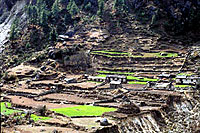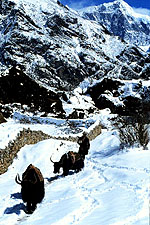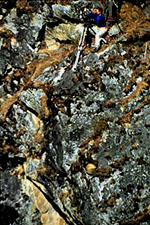 |
 |
 |
 The Approach March
The Approach Marchpart 3 | back to part 2 Lukla Lukla's airstrip is perhaps one of the world's trickiest landing sites. It sits on a mountainside at an 8 degree uphill angle, dead ending at a wall of sheer rock. If you overshoot it, you'll have a firsthand encounter with the Himalaya itself. The air is decidedly thinner here. Yaks and porters arrive ready to be loaded for the trek along a river valley to our lodge in Phakding. (See Map). Square white houses with prayer flags flowing in all directions line the slope at Lukla. Sherpas sit outside the houses and lodges, watching as Ed oversees the loading of the yaks. The valley carved by the Dudh Kosi ("milk river") is a deep ravine with homes and lodges placed on any and all flat ground. Emerald green plots of grass, mustard, kale, and onions, surround the houses. Life happens oudoors here: mothers wash babies on their front stoops and children greet us as we pass by.  On the trail, geophysicist Roger Bilham literally keeps his nose to the ground,
watching the geological story of the Himalayas unfold before him. "What's exciting for me is that from our GPS measurements we have a very good idea of what's happening at a depth of 20 kilometers beneath us and that view of the Himalaya is something most geologists have never had. It puts all the surface rocks into perspective and hopefully we may be able to understand how this region is going to evolve in the future."
Although he has spent many years heading up Global Positioning System (GPS) and
tectonic studies in Nepal, this is Roger's first time in the Khumbu. Click here to hear Roger explain the movement of tectonic plates (RealAudio 149K).
On the trail, geophysicist Roger Bilham literally keeps his nose to the ground,
watching the geological story of the Himalayas unfold before him. "What's exciting for me is that from our GPS measurements we have a very good idea of what's happening at a depth of 20 kilometers beneath us and that view of the Himalaya is something most geologists have never had. It puts all the surface rocks into perspective and hopefully we may be able to understand how this region is going to evolve in the future."
Although he has spent many years heading up Global Positioning System (GPS) and
tectonic studies in Nepal, this is Roger's first time in the Khumbu. Click here to hear Roger explain the movement of tectonic plates (RealAudio 149K).
We all try our best to avoid the yaks. The rule of thumb is to take the high road and stay on the uphill side of the trail to avoid being pushed off. Araceli soon loses to a yak and is pushed off a steep portion of the trail. Yaks rarely, if ever, charge people, but their impressive racks of horns leave us all wary of getting on their wrong side. All along the route, trains of yaks and dzos (a cross between a yak and a cow) with clanging bells crowd the path, laden with gear for expeditions. Click here to hear a yak train (RealAudio 83K).  The team quickly passes
through several villages, arriving at a rickety bridge below Namche Bazaar.
David and his camera crew are there to meet them, having flown into a higher
village the day before. David wants to shoot the bridge crossing from a remote
rock outcrop across the river and has been busy setting up the shot. In all,
it takes the crew 2 hours to get into position and another 2 hours to shoot the
climbers crossing the river. In the finished film less than 15 seconds will be
used.
The team quickly passes
through several villages, arriving at a rickety bridge below Namche Bazaar.
David and his camera crew are there to meet them, having flown into a higher
village the day before. David wants to shoot the bridge crossing from a remote
rock outcrop across the river and has been busy setting up the shot. In all,
it takes the crew 2 hours to get into position and another 2 hours to shoot the
climbers crossing the river. In the finished film less than 15 seconds will be
used.
Continue Lost on Everest | High Exposure | Climb | History & Culture | Earth, Wind, & Ice E-mail | Previous Expeditions | Resources | Site Map | Everest Home Editor's Picks | Previous Sites | Join Us/E-mail | TV/Web Schedule About NOVA | Teachers | Site Map | Shop | Jobs | Search | To print PBS Online | NOVA Online | WGBH © | Updated November 2000 |